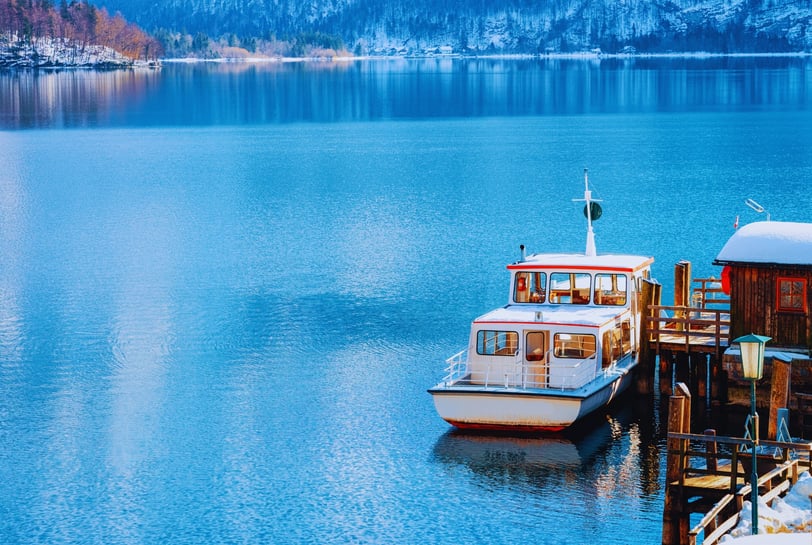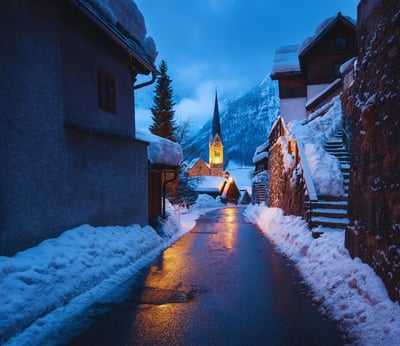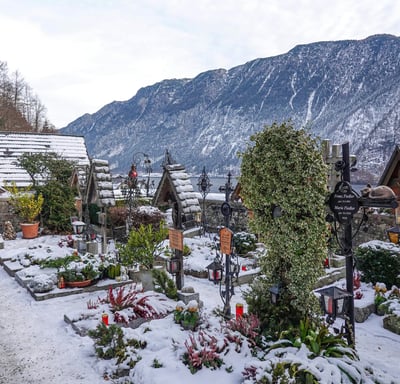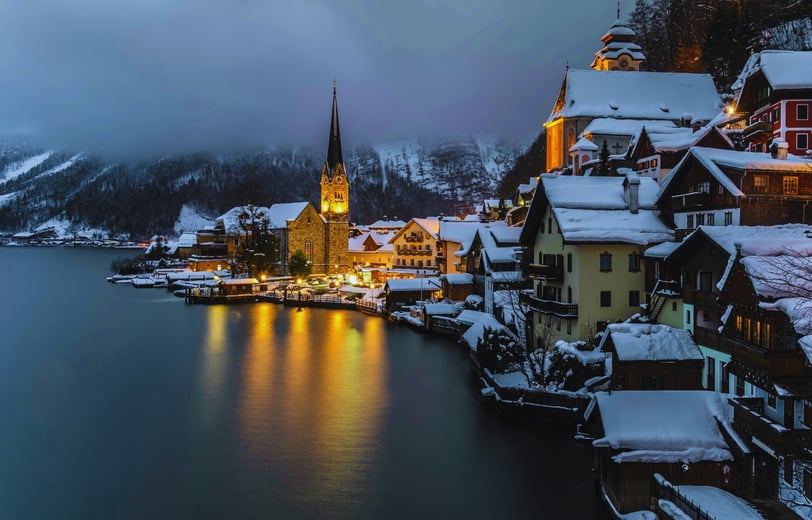The Silence Between Bells: A Hallstatt Reverie


The train to Hallstatt moved slowly, as if unsure it wanted to arrive. I had boarded it in Vienna, watching the urban edges soften into forests and lakes, the landscape gradually letting go of urgency. At Attnang-Puchheim, I changed trains onto a smaller regional line, one that snaked through valleys and shadowed ridges, until finally stopping at a station not in Hallstatt itself, but across the lake—Hallstatt Bahnhof.
From there, a small ferry waited by the dock, rocking gently in the cold water. It was the only way across. The lake appeared first—still as breath held in winter—then the mountains, close and quiet, like old thoughts that no longer needed words. I stepped onto the ferry into a silence so whole, even the snowflakes seemed reluctant to land.
The boat was nearly empty. Just me, a man in a wool coat reading a newspaper from three days ago, and a woman with two tulips wrapped in tissue. As we approached the village, Hallstatt revealed itself without drama—timber-framed houses leaning gently toward the water, a steeple rising from the mist like a question left unanswered.


My guesthouse sat right at the water’s edge, just past the Lutheran church—a two-story villa with green shutters and an old wooden bench facing the lake. Frau Lenz, the owner, wore two cardigans and spoke in half-whispers. “It’s the off-season,” she said, handing me a key. “The village breathes more slowly now.”
The room was small but warm, smelling faintly of old paper and jasmine. There was a pitcher of water on the windowsill, a feather pillow that rustled when touched, and an old writing desk that creaked like it remembered every previous guest. From my window, I could see the ferry landing, half-covered in frost.
That night, I walked the length of the lakefront. No music, no voices—only the sound of water brushing stone, and once, in the distance, the echo of a bell. One chime. Then nothing. It wasn’t loneliness I felt, exactly. More like the echo of someone else’s memory brushing past mine.
There were a few other travelers in town—some seated outside cafés under heat lamps, cradling mugs of mulled wine or coffee, shoulders wrapped in scarves. A small group took photographs from the jetty, their breath rising in clouds. But no one spoke loudly, and no one stayed long in one place. Winter made every gesture softer. It was a season of nods, not words.


The next morning, I visited the ossuary behind the church. Hundreds of skulls—painted, named, arranged in careful rows. Bones of villagers who once walked these same quiet streets. A small plaque read: “To be remembered is to remain.” I stood in silence longer than I meant to, wondering whether silence could also be a kind of prayer.
Later, as snow began to fall, I found a small antique shop near the cemetery. The kind of place lit more by mood than electricity. Inside, I wandered between carved music boxes and faded portraits until I found a wooden drawer with postcards no one ever mailed. One of them showed Hallstatt in a summer long gone. On the back, in barely legible ink:
"The bells rang once, and I thought you might come."
I bought the card and left a coin I didn’t recognize on the counter.
That afternoon, I met a woodworker named Lukas. His shop overlooked the lake, and when I stepped in, he was tuning the strings of an old zither. He didn’t look surprised to see me. “The snow brings listeners,” he said. I asked what he meant, and he smiled: “Some places speak, others sing. Hallstatt listens.”
He showed me carvings of birds and bells, all made from reclaimed pine. One bell had no clapper. “It rings only in memory,” he said, handing it to me. I didn’t ask how he knew I’d understand.


Over the next two days, I wandered. Through alleys that led to nothing. Up staircases that stopped at locked doors. I ate warm bread by myself in a café where the waiter wore a red scarf and called everyone Freund. I wrote letters I didn’t send. I waited for the bells to ring again. Sometimes they did. Sometimes they didn’t.
In the late afternoons, a kind of hushed companionship settled over the village. Travelers walked slowly along the lake or sat under covered balconies with books or steaming drinks. Children slid quietly over frozen patches in the square, their laughter muffled by scarves. It was not a lively place—but it was deeply alive, like a winter breath that had chosen to stay.
On my last evening, as twilight settled over the lake like breath on glass, I stood by the water’s edge and finally heard them—three bells, far away, rising through the mist in slow succession. And then, the silence between.
It was in that silence that Hallstatt spoke: not in words, not in stories, but in space held gently open—for memory, for longing, for things that were never said.
When I left the next morning, Frau Lenz gave me a small envelope. “Someone left this for you,” she said. Inside was the postcard I had bought, with a new message written underneath the old one:
"I was here too. Perhaps we passed each other between bells."
I didn’t look back until the train curved away from the lake. The water was still. The mist was rising. And the village—small, waiting, eternal—was already starting to disappear.


As the train pulled away, I realized that not all journeys must end with answers. Some places leave impressions instead of conclusions—things that remain, not because they were found, but because they were left unresolved.
I looked out the window one last time. The water and mist were unchanged, but something in me had shifted. I couldn’t quite name it—perhaps only the quiet felt more familiar, or perhaps Hallstatt had given me something that could never be put into words.
A faint bell echoed far behind us. Or maybe it was just the train shifting tracks.
If you wish to trace Hallstatt not only through feeling but also through place—through the lens of history and landscape—visit Destinations, “Hallstatt: Reflections of an Ancient Salt Kingdom.”
To further explore Hallstatt's charm through updated insights on its timeless beauty, ancient traditions, and cultural highlights, take a journey to Travel Insights — "Hallstatt 2025: Timeless Beauty, Ancient Salt Mines, and Cultural Highlights."
✉️ Contact:
Curated by TrueTrip Hub |
© 2025 Invisible Atlas — All rights reserved.
Invisible Atlas
Journey Beyond the Visible
invisible.atlas@truetriphub.com
